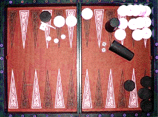
|
Different Ways of Playing

|
Tables and Backgammon
|
|
Tables is the general term for any game played on a backgammon board. Actually, it is bit presumptuous of us to even call it a backgammon board, since backgammon is only 400 years old and some of the other games of tables are thousands of years old.
Most tables games have the following features:
- The board consists of 24 spaces or points.
- Each player has 15 pieces or checkers to move around the board.
- The checkers are moved according to the numbers rolled on a set of dice. Usually two or three dice are rolled together.
|
|
There are three features that distinguish backgammon from other games:
- Starting position. Each player starts with 2 checkers on their respective 24-points, 5 checkers on their mid-points, 3 checkers on their 8-points, and 5 checkers on their five-points.
- Doubles played twice. When you roll doubles, you play each number twice, for a total of four moves. At first appearances, it might seem that this would add to the luck of the game, but exactly the opposite is true. The rule makes backgammon a much more interesting game and actually increases the element of skill.
- Scoring. The winner scores double for a gammon and triple for a backgammon.
A relatively recent feature of backgammon (since the 1920's) is the doubling rule. At any point during a game, one player can insist that the stakes be doubled, otherwise the opponent must resign. While this rule could be used with any tables game, it is most closely associated with backgammon.
|
|
|
In 1931, shortly after the introduction of the doubling cube, a committee of American clubs convened to establish a set of rules which eventually formed the basis of the international rules of backgammon. (You can read the 1931 rules here.) These rules have slowly evolved with time. Modern rules are presented here.
|
|

|
Backgammon Variants
|
|
In the Nack version of backgammon, each player starts with four checkers back rather than two. This leads to longer, generally more skillful games because you can't as easily run your back checkers. See full rules here.
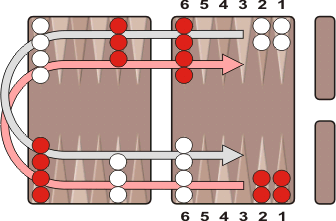
|
|
|
Hyper-backgammon is played using the same rules as backgammon. The only difference is that each player starts with just three checkers, one on each of the opponent's one-point, two-point, and three-point. See full rules here.
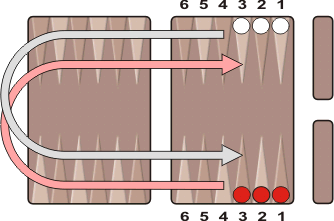
|
|
|
Long-gammon is played like regular backgammon except that both players start with all their checkers on the opponent's one-point. See full rules here.
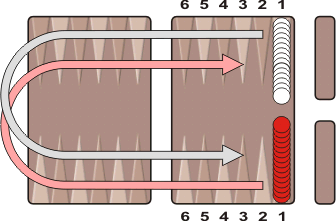
|
|
|
In this game, each player has the opportunity of either rolling the dice again if he doesn't like his own roll, or requesting the opponent to roll again he doesn't like the opponent's roll. You can use your roll-over option only one time per game.
It is helpful if the players each have a special marker denoting their roll-over option. When you use your roll-over, you give up your marker so there is no dispute later about whether it was used. See full rules here.
|
|
|
Also known as misere backgammon, this game is just what it sounds like. The object is to be the last player to bear off all their checkers. Games can be very long, but eventually one player is forced to move his checkers past the other and the game soon comes to an end. (It helps to remember that it's been proven all backgammon games end, even when the players are trying to prolong the game much as possible.) See full rules here.
|
|

|
Acey-Deucey
|
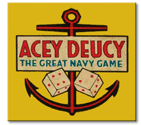 Acey-deucey is a popular backgammon variation and a longtime favorite of the U.S. Navy, Marine Corps, and Merchant Marine. The distinguishing feature of the game is the roll of Acey-deucey is a popular backgammon variation and a longtime favorite of the U.S. Navy, Marine Corps, and Merchant Marine. The distinguishing feature of the game is the roll of   , called acey-deucey, which gives the player who rolls it extra turns. The worst roll of regular backgammon is the best roll in acey-deucey. , called acey-deucey, which gives the player who rolls it extra turns. The worst roll of regular backgammon is the best roll in acey-deucey.
|
|
|
Players start with all their checkers off the board. You enter your checkers in the opponent's home board and move them around the board from there. You don't have to wait for the all your checkers to be entered before you can begin moving the checkers already entered.
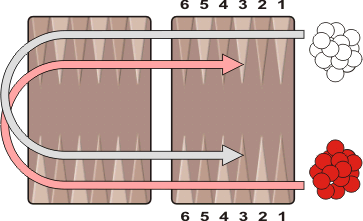
The best roll possible is 1 and 2 (acey-deucey). When you roll acey-deucey, this is what happens:
- First you play the
  in the normal way. in the normal way.
- Then you name any roll of doubles you wish and play it accordingly.
- Then you roll and play again. If you rolled another acey-deucey, you keep going—naming and playing a double of your choice and rolling again.
If at any point you are stuck and cannot play the full roll, your turn is over.
The player who first bears off all of his checkers wins the game and the loser pays him one point for each checker still on the board. See full rules here.
|
|
|
European acey-deucey is another popular game. As with American acey-deucey, all the checkers start off the board and you enter them into your opponent's home board.
A special feature of European acey-deucey is what happens when you roll doubles.
When you roll doubles, the numbers on the top of the dice are played twice each (as in backgammon), then the numbers on the bottom of the dice are played twice each. Opposite sides of a die always total 7. So if you roll   , you have four 2's to play, and then four 5's to play. And then you roll again! , you have four 2's to play, and then four 5's to play. And then you roll again!
Rolling 1 and 2 (acey-deucey) is even better. Here's what happens:
- First you play the
  in the normal way. in the normal way.
- Then you name any roll of doubles you wish and play it accordingly—first the numbers on top of the dice, then the numbers on the bottom.
- Then you roll again.
If at any point you are stuck and cannot play the full roll, your turn is over.
You must bear off exactly. For example, if you have a checker on the four-point, the only way to bear it off is to roll a 4. You may not use a 5 or 6 to bear off from the four-point.
The first player to bear off all of his checkers wins the game and scores one point. There are no gammons or backgammons. See full rules here.
|
|

|
Greek Backgammon
|
|
Tavli means board in Greece. It also the Greek name for games played on a backgammon (tavli) board. The three common games of tavli are portes, plakoto, and fevga. These games are played one after another in matches of three, five, or seven points.

Just one pair of dice is used and this is shared between the competitors. For the first game, each player rolls one die and the higher number goes first. But, unlike in backgammon, the player who wins the opening roll rolls both dice again to begin his first turn. After the first game, the winner of the previous game goes first.
There is no bonus for a backgammon (triple game) in tavli. And no doubling cube is used.
Tavli is played very quickly. You don't have to wait for your opponent to pick up the dice—just pick them up yourself while he is making his move. But don't roll too quickly. As long as opponent still has checker in his hand, or even a finger on a checker, you must wait.
|
|
Portes is essentially the same game as Western backgammon. The differences are:
- If you win the opening roll, you roll again for your first turn.
- The winner of the game receives one point for a single win and two points for a gammon; there is no triple game or backgammon.
- You don't use a doubling cube.
See full rules here.
|
|
|
Each player starts with fifteen checkers on the opponent's one-point. The checkers move around the board in opposite directions as shown below.
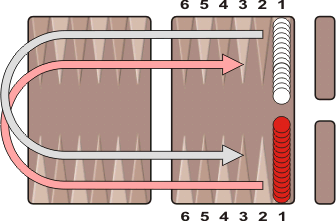
The interesting feature of plakoto is what happens when you land on an opposing blot. You don't hit the blot, you pin it. This turns plakoto into a completely different game than backgammon.
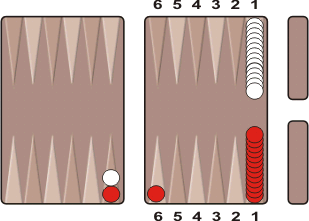 |
|
White's checker has come around the board and now pins Red's checker on the seven-point.
|
When you are pinning an opposing checker, you now own the point. His pinned checker cannot move until you release it. And only your checkers may land on that point.
The object of the game is the same as backgammon, to get your checkers around the board and borne off first. If the winner bears off all of his checkers before the opponent has borne off any of his, he scores two points; otherwise he gets just one point. See full rules here.
|
|
|
There are two unusual things about fevga. The first is that both players move their checkers around the board in the same direction. Each player starts with fifteen checkers on the rightmost point of the opposite side of the board and moves them counterclockwise as shown in the diagram below.
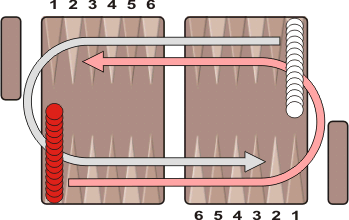
In this diagram you are White. You move your checkers counterclockwise around the board and bear them off at the lower right. Your opponent will bear his red checkers off at the upper left.
The other unusual thing about fevga is there is no hitting. Fevga is entirely a game of blocking. Even a single checker on a point controls that point, and only additional checkers of the same color may land there. See full rules here.
|
|

|
Other Games
|
|
The term trictrac today is most commonly used simply as the French name for backgammon. But real trictrac is a different game, popular in France from about 1500 to the middle of the nineteenth century.
The equipment is the same as in backgammon and players each have fifteen checkers which they move around the board according to rolls of the dice. Unlike backgammon, however, racing plays only a small role in the game. The goal is to score points for particular positions and movements.
The rules are quite elaborate. For complete rules, see How to Play Trictrac.
Fans of trictrac will enjoy visiting David Levy's web site devoted to the game.
|
|
|
Russian backgammon is a true race, with both players entering in the same starting table, moving around the board in the same direction, and bearing off from the same finishing table table.
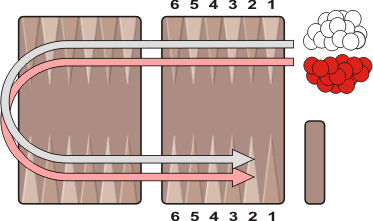
Most of the other rules are just as in backgammon. The major exception is how doubles are played. When you roll doubles, the numbers on the top of the dice are played twice each (as in backgammon), then the numbers on the bottom of the dice are played twice each. Opposite sides of a die always total 7. So if you roll   , you have four 2's to play, and then four 5's to play. See full rules here. , you have four 2's to play, and then four 5's to play. See full rules here.
|
|
|
Despite the name, French backgammon bears no resemblance to trictrac. All checkers start off the board and players move in opposite directions around the board, like this:

When you roll doubles, the numbers on the top of the dice are played twice each (as in backgammon), then the numbers on the bottom of the dice are played twice each. Then the player who rolled doubles gets to roll again. See full rules here.
|
|
|
Dutch backgammon is another popular backgammon variant. All checkers start off the board and players move in opposite directions around the board as in French backgammon. The unique feature of Dutch backgammon is that you are not allowed to hit your opponent until you have at least one checker home. See full rules here.
|
|
|
Snake is an asymmetric game, and a lot of the fun is trying to figure out which side has the advantage. White starts with his fifteen checkers set up in the normal way. Red starts with nine checkers on the bar, and two checkers on each of White's one-point, two-point, and three point.
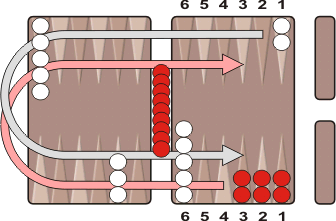
The rules are the same as in backgammon but the strategy is quite different because of the unusual nature of Red's position. You get a lot of practice playing and defending an extreme back game.
|
| |
More Information
|
The Backgammon Forum Archive has descriptions of several other games:
- Backwards Play: You may move your checkers either forward or backward according to the number rolled.
- Bad Advice: On each turn, your opponent "suggests" a move for you to make. If you don't follow his suggestion, he can veto (once only) your alternate choice.
- Chase: Both players set up and play clockwise, moving around the board in the same direction.
- Duodecagammon: Backgammon played with 12-sided dice.
- Exact Bearoff: When bearing off, you must roll the exact point number of a checker to be able to take it off.
- Fixed-dice Backgammon: The opening roll is repeatedly played for the entire game.
- Gerhardsen: The winner of the game rolls two dice, and if he rolls 2-1 the result is reversed.
- No Hit: If you hit your opponent, you lose.
- Nuclear Backgammon: At any point in the game, a player may launch a "nuclear attack," sending all blots (yours and his) to the bar.
- One-Roll Lookahead: You get to see the opponent's next roll before completing your play.
- Skewed-dice Backgammon: One player uses regular dice; the other uses one four-sided die and one eight-sided die.
- Sudden Death or Hit Man: First player to hit a shot wins the game.
- Tracy Turn-Around: If your opponent drops a cube that you think is a take, you may ask him to pay twice the normal amount for dropping and continue the game with the sides reversed.
- Woodpecker: This game has a two-stage doubling rule, as though you are playing with two doubling cubes which cannot be used simultaneously.
|
|

|
Forms of Competition
|
|
Money play backgammon is the standard form of play. You play one game at a time against your opponent for an agreed stake per point. A doubling cube is used, so the stakes may increase as the game goes on.
Here is an illustration of a money play session between Al and Bert for $5 a point.
| Game | Description | Cube
Value | Type
of Win | Points |
| Al | Bert |
| 1. |
Al wins the first game when he doubles and Bert drops. |
1 |
Single |
1 | |
| 2. |
This time Bert doubles and Al accepts. Bert goes on to win a single game. |
2 |
Single |
| 2 |
| 3. |
Bert doubles early, but Al turns the game around and wins a doubled gammon. |
2 |
Gammon |
4 | |
| Total |
5 | 2 |
Al won a total of 5 points and Bert won 2 points. At $5 a point, Bert now owes Al $15.
The following rules apply to money play:
- Jacoby rule. This rule says that gammons don't count unless there has been a cube turn during the game. The rule has become pretty much standard in money play.
- Beavers. This optional rule says that after a player accepts the opponent's double he may immediately redouble and retain possession of the cube.
- Automatic doubles. This optional rule says when both players roll the same number at the start of a game, the doubling cube is turned to 2 and stays in the middle.
|
|
|
When you don't want to play for money, match play is a popular alternative. This is the style of play used in tournaments and on many online play sites.
A match is played to a specified number of points. The first player to accumulate the required points wins the match. Points are awarded in the usual manner: 1 for a single game, 2 for a gammon, and 3 for a backgammon. The doubling cube is used, so the winner of each game receives the value of the game multiplied by the final value of the cube.
One additional rule of match play is the Crawford rule, which says that a player who gets to one point short of victory may not double in the immediately following game. Automatic doubles, beavers, and the Jacoby rule are never used in match play.
For more information, see: WHAT IS MATCH PLAY?
|
|
|
A freeze-out match works like a poker game. Players start with an equal number of poker chips and continue playing until one player loses all their chips. For example, players might start with ten poker chips each. Every game the loser pays the winner from his supply of chips. When one player runs out of chips, he loses the match.
Gammons and backgammons count as usual. The doubling cube is used in the normal way, so the winner of each game receives the value of the game multiplied by the final value of the cube.
Freeze-out matches use table-stakes betting. That means you cannot win more in one game than you can lose, so the best you can ever do in a single game is double your money. For example, suppose you are down to three chips and win a doubled gammon. Normally you'd collect four points, but the table-stakes rule says you collect only three points.
Automatic doubles, beavers, and the Jacoby rule are not used in freeze-out matches. And there is no need for a Crawford rule because the table-stakes rule prevents a player from winning more than one point when he is down to his last chip.
If you are worried about a freeze-out match taking too long, you can institute an accelerated doubling cube rule. For example, you might say that after four games the cube starts each game at 2, and after another four games the cube starts each game at 4, etc. See post by Dave Brotherton.
|
|
|
Duplicate backgammon was inspired by duplicate bridge. Multiple games are played simultaneously on different tables. Dice throws are made at one table and communicated to the others, so all players playing in the same position at different tables receive the same rolls.
You are competing not so much against your opponent across the board as you are against players in the same position at other tables. The idea is, if the other players receive the same dice rolls as you do, any difference in result must be due to skill rather than luck.
Unfortunately, it doesn't work out that well in practice. Even with expert players, it is amazing how quickly two games can diverge. Once the positions are different, a good roll at one table can be a disastrous roll at the other.
Today, duplicate backgammon remains mostly a novelty and is rarely played in tournaments. For more information, see How to Play Duplicate Backgammon.
|
|

|
Table Stakes
|
|
The idea of table stakes is standard in poker but relatively new in backgammon. It is used on play sites that allow playing for real money. Here is how it works:
Two players agree between them on a win limit which applies to the game. The win limit is the maximum amount that either player can win or lose.
Typically, the win limit is the lesser amount of money that the two players bring to the table. Say Player A brings $100 to the table and Player B brings $20 to the table, then the win limit would be $20, though the players could agree to make it less than that if they wanted to. See post by Carlo Melzi.
|
|
Table stakes has the following advantages when playing for money:
- It guarantees that the winner gets paid. Since both players must have enough money on deposit to cover their maximum loss there is never a problem for the winner to collect. This is obviously an important feature. In unlimited money play, there is always a chance that the stakes could get so high that the loser would not be able to pay.
- It is fair to both parties. The maximum you can win equals the maximum you can lose. If you didn't have this rule, and each player's losses were limited to the cash he had on hand, it wouldn't be fair to the player with more cash—he would be risking more to gain less.
|
|
|
The presence of a win limit means that sometimes gammons and redoubles have less value than they do in regular money play. If the win limit is high compared to the value of the cube, there isn't much affect on cube handling. But as the value of the cube increases, you sometimes encounter strange effects.
If you are offered a cube that is exactly equal to the win limit (e.g., you are redoubled to 4 and the win limit is 4), then there will be no redoubles in this game and no bonus for winning a gammon. Your take point in this situation 25 percent; that is, you should take the cube if your chances in the game are greater than 25 percent and drop the cube if your chances are less than 25 percent.
If you are offered a cube that is greater than the win limit, you can often take with very little chances in the game. For example, if you are offered an 8-cube and the win limit is 5, you can take with as little as 10 percent winning chances.
The following tables show the effects of different win limits on your take point.
|
|

|
Chouette
|
|
Chouette is a social form of backgammon for three or more players. One player, the box, plays on a single board against all the others who form a team lead by a captain.
To determine the order of play, players each throw one die, and rerolls are used as needed to break ties. The player rolling highest becomes the box; second highest becomes the captain of the team playing against the box. The captains plays for the team, and has the final say on all checker-play decisions.
When the box wins a game, he collects from each team member and retains his position as the box. The captain goes to the back of the line and the next player on the team becomes the new captain.
When the team wins a game, the box pays off to each team member and goes to the end of the line. The captain becomes the new box, and the next player in line becomes the new captain.
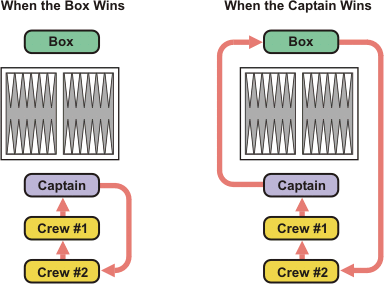
Players can leave or join a chouette at any time. A new player starts at the bottom of the rotation.
|
|
|
A chouette may be played with either a single doubling cube or multiple cubes. In a single-cube game, the only decision that the members of the team make individually concerns takes. If the box doubles, each team member can decide on his own whether to play on or drop out. Those who drop out each pay off to the box and no longer participate as team advisers. If the captain drops out while there are others on the team who wish to play on, the captaincy is assumed by one of these players and the previous captain drops to the bottom of the rotation.
Most chouettes today use multiple cubes. Each member of the team has his own doubling cube. The box can double the individual team members, and each team member can decide whether and when to double the box. With multiple cubes in play, it is possible for the box to win against some players while losing against others. So the question arises, when does a player get to keep the box? The usual rule is that a player retains the box if he defeats the captain. See: When does a player retain the box?
|
|
|
Customs vary as to the rights of the team. In some chouettes, they may consult freely as to how rolls should be played. Too much consulting, however, can really slow the game down, so many chouettes ban consulting. A popular compromise permits consultation only after the cube has been turned. See: When is consulting allowed?
|
|
|
This is a rule that says: if some players take box's initial double and other players drop, a team member who accepted the double is obliged to accept an extra 2-cube from any other member that wishes to pay him one point. The receiver of an extra now has multiple cubes which he may use individually to redouble, and which he will pay on or collect from in the usual way. See posts by Daniel Murphy, Albert Steg, and Anthony Wuersch.
|
| |
More Information
| |
|

Return to
: Backgammon Galore
: FAQ

|















 Acey-deucey is a popular backgammon variation and a longtime favorite of the U.S. Navy, Marine Corps, and Merchant Marine. The distinguishing feature of the game is the roll of
Acey-deucey is a popular backgammon variation and a longtime favorite of the U.S. Navy, Marine Corps, and Merchant Marine. The distinguishing feature of the game is the roll of 
 , called acey-deucey, which gives the player who rolls it extra turns. The worst roll of regular backgammon is the best roll in acey-deucey.
, called acey-deucey, which gives the player who rolls it extra turns. The worst roll of regular backgammon is the best roll in acey-deucey.





